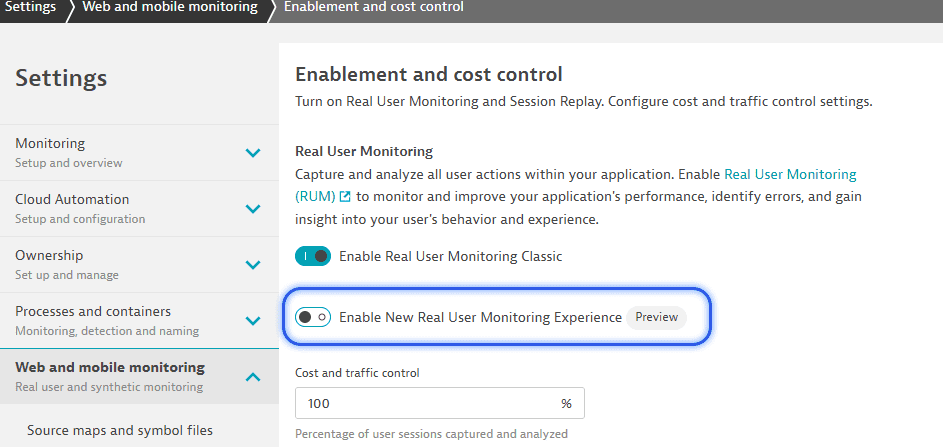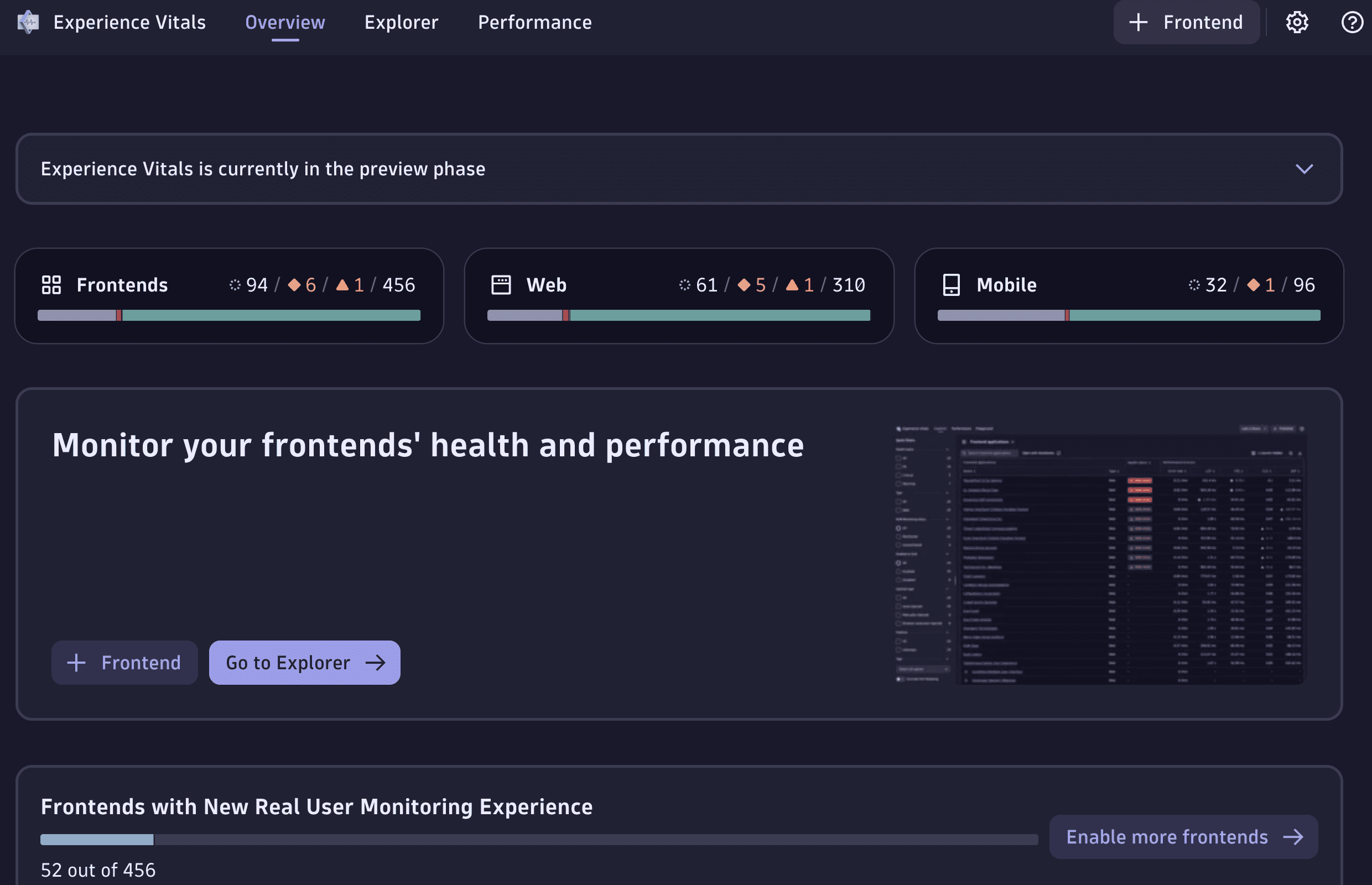New RUM Experience settings
- Latest Dynatrace
- Reference
- 2-min read
- Preview
You can view and edit settings of the New RUM Experience via two main apps:
- In
 Settings, all settings are accessible.
Settings, all settings are accessible. - In
 Experience Vitals, the most frequently used settings are integrated, and you can review and edit them for individual frontends.
Experience Vitals, the most frequently used settings are integrated, and you can review and edit them for individual frontends.
In general, some changes in configuration such as cost control or most privacy-related settings may impact both the Classic and New RUM Experience. Others, such as the new session and event properties setting, impact only the New RUM Experience.
Prerequisites
To use the New RUM Experience, make sure that you have:
- Classic RUM enabled.
- OneAgent version 1.301+ if you want to enable it at the environment level.
Enablement and cost control
Cost control is applied to RUM experiences in both the previous and latest Dynatrace.
To enable New RUM Experience on an environment, open Settings and go to Collect and capture > Real User Monitoring > Traffic and cost control > Frontend - web or Frontend - mobile, depending on your tenant, and turn on Enable New Real User Monitoring Experience.

For individual frontends, you can also enable new RUM through Experience Vitals. Since the New RUM Experience is still in preview, you might encounter problems if not carefully configured.
Session Replay
Session Replay isn't enabled yet within the New RUM Experience, which is why you can only use the Enable Session Replay Classic option.
Experience Analytics
Experience Analytics is a Real User Monitoring (RUM) package that provides deep visibility into user behavior and experience. It includes User Interactions, capturing clicks, taps, scrolls, and inputs to reveal how users engage with your application. Coming soon, the new Session Replay will allow teams to visually replay real user sessions for faster troubleshooting and UX validation. Together, these capabilities help teams optimize journeys, reduce friction, and make data-driven decisions to improve digital experiences.
Frontend configuration
Changing the frontend name in RUM settings affects both RUM classic and New RUM Experience as well. After you change it, you'll need to use the name name in your DQL queries.
Privacy
All data privacy settings are respected by the New RUM Experience as well, including:
- Masking personal data in URIs
- Using persistent cookies for user tracking
- Data collection and opt-in mode
- Complying with "Do not Track" browser settings
- IP masking
You can use our new event modification API to mask certain user event fields on capture. We're planning to introduce additional privacy features.
Frontend detection
Frontend detection (application detection) rules are also respected by the new RUM experience. Within  Experience Vitals, we also show the detection rules on the frontend level, allowing you to get an understanding of which rules apply to a specific frontend. However, as a rule higher up in the list already determines where the traffic is routed to, we recommend always reviewing the environment setting as well.
Experience Vitals, we also show the detection rules on the frontend level, allowing you to get an understanding of which rules apply to a specific frontend. However, as a rule higher up in the list already determines where the traffic is routed to, we recommend always reviewing the environment setting as well.

XHR Settings
Exclude XHR requests from monitoring
Specify a regular expression to match all URLs that should be excluded from becoming XHR request events. Dynatrace supports the JavaScript regular expressions syntax. The separation between different protocols of the URIs is not supported, so every protocol of the URI will be excluded.
Event and session properties
Event and session properties let you attach custom-defined key-value pairs to user events and user sessions, using the namespaces event_properties and session_properties.
Before you start sending event or session properties
Event and session properties must be configured before they can be used. Incoming event and session properties that are not configured are dropped during event ingest.
To configure an event or session property
- In
 Experience Vitals, select the frontend for which you want to add the property.
Experience Vitals, select the frontend for which you want to add the property. - In the Settings tab, select Event and session properties.
- Depending on whether you want to configure an event or session property, click Add under either Defined event properties or Defined session properties.
- In Field name, specify a name, for example
cart.total_value. - If you want field name validation to be case insensitive, enable Field name validation should be case-insensitive.
- Under Datatype, select one of the available types—either
string,boolean, ornumber.
Note that the field name is always prefixed with either event_properties. or session_properties., depending on the selected type, for example event_properties.cart.total_value
How to send properties
Currently, event and session properties can only be sent via the New RUM APIs.
Limits
- Naming
- Field name maximum length: 100 characters (including the
event_properties./session_properties.prefix). - Allowed characters in field name: A–Z, a–z, 0–9, underscore
_, and dot..
- Field name maximum length: 100 characters (including the
- Counts
- Maximum of 20 event and session properties can be configured
- Values
- For event and session properties of data type string, the length is limited to 1000 characters.